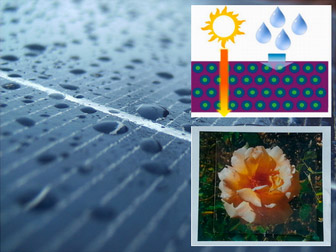
Scientific Achievement
Working through DOE’s Bay Area Photovoltaic Consortium, researchers at the Molecular Foundry created an optically transparent composite that improves water vapor blocking by 3000 times.
Significance and Impact
Corrosion of solar cell electrical contacts by water is a leading cause of device failure.
Research Details
- In addition to photovoltatic cells, highly efficient gas barrier materials that are thin, flexible and transparent are required for a wide variety of applications, from food and drug packaging to electronic displays and devices.
- Current approaches are either are not cost-effective and challenging for large-scale manufacture (metal or inorganic films) or not an ideal barrier (polymer-based materials).
- This self-assembling organic–inorganic composite material may lead to the best of both worlds.
- A block copolymer provides transport obstacles for incoming water molecules while inorganic magnesium oxide (MgO) nanocrystals enabling moisture scavenging.
- The nanometer scale and excellent dispersion of the nanocrystal allowed the films to remain transparent

